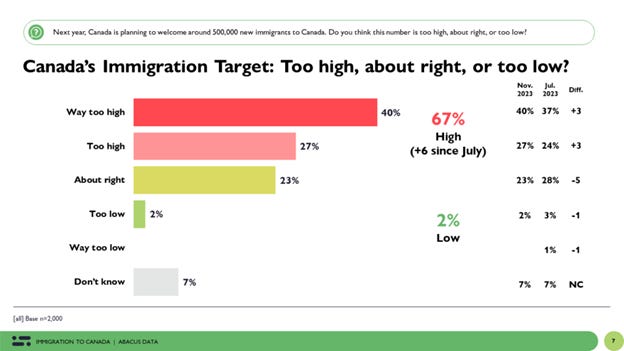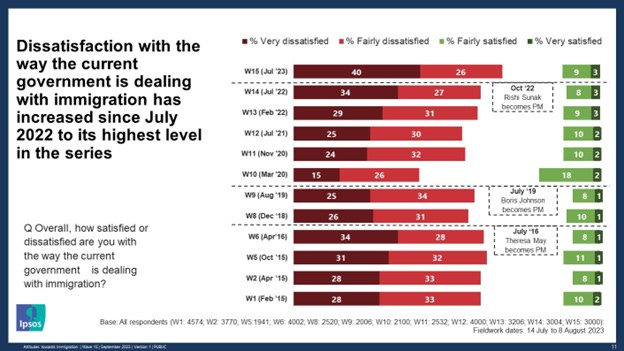Almost exactly one year ago today I tentatively waded into the dangerous waters of the immigration debate. At the time I considered it the “third rail” of politics, touch it and you die. How much has changed in a year. If you’ve been following the news, it’s almost impossible to avoid seeing something directly or indirectly dealing with immigration. In the UK, riots erupted last week after 3 children were stabbed to death and eight more children and two adults injured by an assailant rumored to be an asylum seeker. Meanwhile, in the US, President Donald Trump has stated he will begin “mass deportations” of illegal immigrants, while even the Democratic candidate for President, Kamala Harris, has admitted immigration is broken (but is still promising amnesty for illegal immigrants). Even in “nice” Canada public opinion, once wholeheartedly in support of immigration, has turned negative. How did we get here?
The short answer is a combination of social (not legal) censorship, government incompetence, and elite arrogance. This is a complicated topic and I’m faced with a decision here, attempt to cram everything into one (relatively) short post, or break this into two or more posts and hope I complete the series before I’m distracted by something shiny and new. I’m going to risk it and break this into parts. Before we get into the underlying problems let’s address the first question, “do we need immigration?”
Why is immigration necessary?
The question is not “do we need immigration” but “why is it necessary?” The answer, put simply, is demographics and economics. When discussing immigration policy, there are two policies that will bring about social/societal collapse: 1) Open borders and 2) Closed borders. Open borders lead to rapid population increases, driving wages down, leading to cultural tensions (see the UK), straining infrastructure and public services (ex. healthcare, education, and housing), and potentially leading to the radicalization of certain groups of immigrants. While open borders are a fast road to ruin, closed borders will get you there too because of something called “the replacement rate.”
The replacement rate is the level at which a population replaces itself from one generation to the next and is typically defined as 2.1 children per woman. The only OECD nation to meet this rate is Israel at 2.9. The average rate of the OECD is 1.6.
By Korakys - Own work, CC BY-SA 4.0, https://commons.wikimedia.org/w/index.php?curid=92951369
Without immigration, populations will decline. Japan, with a birth rate of 1.3 and an immigration rate of 0.7 per 1000 population (Canada’s is 5.3, the US is 3, and the UK is 2.9) provides the perfect example. If nothing changes the Japanese population is set to decline between 25% to 30% over the next 50 years.
The Growth Trap
At this point most, if not all of us, probably have a sense that a declining population is not a good thing. Even if we can’t quite explain why. We citizens have many expectations, high employment, economic stability, individual freedom, access to healthcare, public safety, a social safety net…and the list goes on. All of these are reliant on economic growth. Examining the situation in Canada reveals the issues faced by every OECD country (except Israel).
Canada’s population growth slowed in the second half of the 20th century from an average annual rate of 2.7% in the 1950s to 1.1% since the turn of the century. This combined with an increase in life expectancy has resulted in the share of those over the age of 65 increasing from 14.1% in 2010 to 19.0% in 2022 and is expected to rise to 25% before stabilizing in mid-century. This trend will have a negative impact both on economic growth and the cost of transfer payments to seniors.
In 1950 Canada’s the number of working age people to retirees was 7.7:1 and Canada’s population pyramid looked like this:
From an economic standpoint this is very healthy as there are more young people capable of supporting the older retirement age population. Today the working age to retiree ratio has dropped to 3.4:1 and the pyramid looks like this:
Put simply, the number of young people is no longer sufficient to support the number of people at or near retirement age and the ratio is expected to worsen unless the working age population increases.
Similarly, the decline in the relative size of the labor force compared to the overall population will slow economic “growth by an average of 0.2 percent” per year through 2050. While this may not seem like a big number, if Canada’s annual GDP growth rate was 1.8% instead of 2% through 2050 it would have the following implications:
Cumulative Impact: The cumulative effect of a 0.2% lower growth rate over 26 years is would potentially lead to GDP being lower by $160 billion
Government Revenue and Spending: Lower GDP growth would reduce government revenues (e.g., through lower tax receipts) and spending capacity which in turn could negatively impact public services, infrastructure investment, and social programs.
Debt and Deficits: Should the government decide not to reduce spending on public services, infrastructure, and social programs, slower GDP growth would result in a higher debt-to-GDP ratio.
Investment and Confidence: Persistent lower growth might impact business investment and economic confidence, potentially leading to a slower pace of innovation and development.
Living Standards: Reduced economic growth could affect employment rates, wage growth, and overall living standards, potentially leading to lower average income levels compared to a higher growth scenario.
The economic ramifications of our current demographic situation mean that the life we have become accustomed to, and the retirement we all look forward to, is in jeopardy if some way is not found to increase the ratio of workers to retirees.
Conclusion
"There are no solutions, only trade-offs" reflects a fundamental principle in decision-making and problem-solving, particularly in complex systems. The statement emphasizes that every decision or policy choice involves balancing different factors and making compromises, as there are often no perfect or one-size-fits-all solutions. If immigration is taken off the table, society is faced with several distasteful and/or improbably decisions:
Dramatically increase the birth rate
Raise the retirement age
Reduce government transfers to retirees
Live with a lower standard of living
Bullet 1 is a non-starter as it is a matter of individual choice and while incentivizing large families is possible, it is not something that can be mandated (and even if it could, there’s at least a 20-year lead time before it would have an impact). Raising the retirement age and/or reducing retirement benefits would be possible but are unlikely in democracies as few people are likely to vote to work longer or reduce their own benefits. Proof of this is already evident in the US where social security is expected to be depleted by 2035 and yet there remains little appetite for dealing with this politically. The final option is to live with a lower standard of living. This is less of an option than it is an inevitability if a solution to the demographic crisis is not found.
Eliminated options 1 through 4, leaves society with only one solution, immigration. Up until very recently this wasn’t a problem as immigration was widely viewed as a positive in Canada, the UK, and the US. However, the mood has shifted as these charts show.
Having answered the easy question, “why is immigration necessary,” we are left with two more difficult questions, why is the public souring on immigration and what can be done about it?
Questions that will have to wait until next time.
Towards a sane immigration policy
In my previous immigration article we answered the question, “do we need immigration?” While the obvious answer was “yes,” we only tangentially addressed the numbers question by eliminating open borders as a rational approach. This still leaves us with two important, and arguably harder questions:













I think open borders are a disaster.
I immigrated to Germany (Yes yes call me gatekeeper, ladder-puller w/e i don't care).
And i can definitely see the effects of *Unchecked* immigration almost daily.
You are either a thriving socialist-democracy (a concept i believe in), or you have open borders. You cannot do both.
But. Closed borders also present a problem.
It sounds well and good to only allow professionals or academically inclined people to immigrate to your country after some scrutiny. But there are also cultural gaps to pay attention.
I wrote some comment a few days ago about the inflation of degrees in Germany, putting many young Germans behind the professional curve in comparison to Israel (which is hysterical considering Israelis have to waste 3 years in a military service), the US and certainly some Asian countries which I'm less knowledgeable about.
Many Germans will not be able to compete with those immigrants who have much more experience compared to age when it comes to those jobs and opportunities. That will simply bring us back to square one. Locals being against immigration.
Phil,
This was an excellent post—well balanced on the whole.
I especially love your unstated use of “opportunity cost”—“There are no perfect solutions, only sets of tradeoffs”. (Thomas Sowell is a great proponent of this economic concept)
I would like to point out that you forgot to mention that increased employment can lead to lower wages AND LOWER PRICES due to the forces of supply and demand in the labor market. When more people are employed, the supply of labor increases, which, all else being equal, can drive down the price of labor (wages). Simultaneously, increased employment can lead to increased production of goods and services, potentially lowering their prices due to increased supply and competition.
You might consider explaining the difference between nominal wages and real wages. The fact that a worker’s wages remain higher or conversely become lower tells us very little about his actual wealth or economic condition.